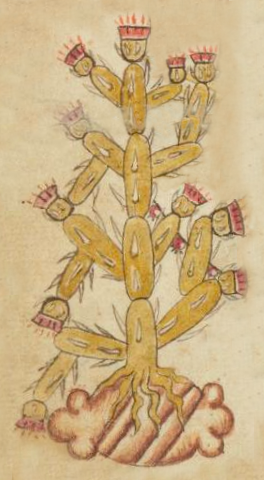Tenochtitlan (Azca20)
This painted black-line drawing is the compound hieroglyph for the place name Tenochtitlan. The name starts at the bottom as a horizontal stone with the usual diagonal stripes and curling ends. It is painted red, pink, and partly left natural. Coming up vertically from the stone is a large nopalli cactus with about sixteen branches (pencas, in Spanish) plus a trunk, all painted gold but with the spines left natural. Flowers that are becoming fruits (nochtli) appear at the ends of the outermost pencas, eleven in all. These are gold fruits with a red-and-white fringe of flower petals at the top.
Stephanie Wood
We are calling this a glyph even lacking a gloss, being certain of its interpretation when based upon comparisons with other compound glyphs of this name. Normally, what are called iconographic examples in this digital collection are so labelled due to the lack of a confirming gloss. However, ideally, comparisons with glossed glyphs will help bear out the interpretations. Note the examples of Tenoch and Tenochtitlan glyphs, below.
Stephanie Wood
post-1550, possibly from the early seventeenth century.
Jeff Haskett-Wood
nopales, tunas, frutas, plantas, piedras, imperio, ciudades, topónimos, nombres de lugares

Tenochtitlan (the capital city of the Mexica), https://nahuatl.wired-humanities.org/content/Tenochtitlan
Tenochtitlan
Stephanie Wood
The Codex Azcatitlan is also known as the Histoire mexicaine, [Manuscrit] Mexicain 59–64. It is housed in the Bibliothèque Nationale de France, and hosted on line by the World Digital Library and the Library of Congress, which is “unaware of any copyright or other restrictions in the World Digital Library Collection.”
https://www.loc.gov/resource/gdcwdl.wdl_15280/?sp=20&st=image
The Library of Congress is “unaware of any copyright or other restrictions in the World Digital Library Collection.” But please cite Bibliothèque Nationale de France and this Visual Lexicon of Aztec Hieroglyphs.









